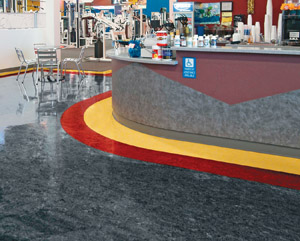 |
| Armstrong’s Marmorette |
|
By Kathlene Vercellino
Hicksville, N.Y.—With oil prices at record highs, the focus on environmentally friendly products is greater than ever. Within the flooring industry two of the better known substantially green products fall within the resilient category—rubber and linoleum.
The A&D community continues to take the lead in using eco-friendly products as designers, specifiers and architects search out what’s new, stylish and safe in goods for both the home and office. Rubber floor covering is one of those choices that many professionals are either just finding out about for the first time or, in many cases, they are rediscovering.
“The popularity of recyled rubber flooring is on the rise because of its green attributes,” said Kathleen Keller, director of marketing for
Dodge-Regupol, manufacturer of
ECOsurfaces. “Benefits such as high-recycled content, low VOC emissions and low life-cycle costs, make it an environmentally-friendly flooring solution for a number of applications.
“For instance,” she contined, “our new ECOsand line was designed to integrate with the latest trends in commercial interiors including flooring surfaces, wall and window coverings, furniture and more.”
Rubber flooring can make a significant contribution to sustainability, noted Rachel Tipton,
Johnsonite’s communications coordinator. “It has a functional life of over 30 years. This minimizes the use of raw materials and consumed energy needed to replace the flooring.
“Much of the post-industrial scrap is reused within the production of many rubber flooring products such as Johnsonite’s Replay and Triumph,” she continued. “Also, it can be installed with VOC-free adhesives. Plus, rubber does not inherently promote growth of mold or bacteria and it requires no phosphates or solvents for cleaning.”
Similar to rubber, linoleum holds much of the same qualities. Products are made from natural, readily renewable materials or a combination of both.
Armstrong’s
Dominic Rice, vice president of commercial resilient products, added, “In addition to being made from renewable raw materials, it also has a very long life. Linoleum will last for decades and, generally speaking, it is replaced not because the product is not performing its function but because the end-user is tired of the color or look—it becomes dated. The advantage of this is that the less you have to replace a product the less impact you have on the environment.”
To make the public more aware of eco-friendly products manufacturers are getting the word out in a variety of ways. “We’ve been attending eco shows on a regular basis to educate retailers, designers, architects and others on the benefits of using linoleum,” concluded
Diane Martel,
Tarkett Commercial’s vice president of maretking.